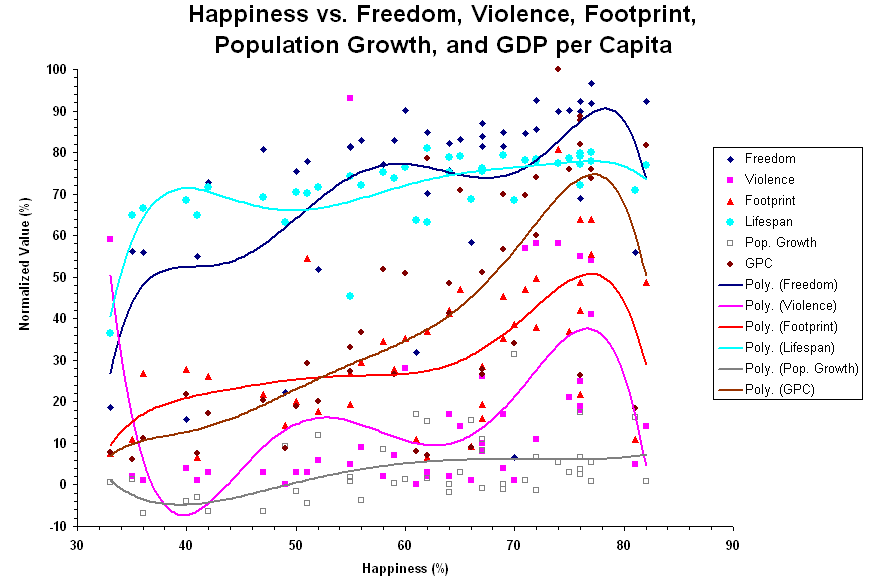Happiness There appears to be a rough correlation between quality of life ("happiness") and several variables, as shown below for a sample of 43 countries for which all the data is known:
Values are normalized to percent of maximum, and collected from data valid in the 2002-2004 time frame. "Happiness" is a measure of quality of life, as defined by the World Database of Happiness (1). "Freedom" is a composite of three indicators of freedom tracked by the World Resources Institute (2): level of civil liberties, polity (level of democracy), and press freedom. "Violence" is assaults per capita (3). "Footprint" is per capita global ecological footprint (4). Lifespan is life expectancy, and population growth is the difference between births and deaths per 1,000 people (5). "GPC" is Gross Domestic Product per capita (6). Variables above can also be plotted as a function of footprint:
See Power for analysis based on a random population, along with a table of values. References and Notes: (1) Veenhoven, R., World Database of Happiness, Erasmus University Rotterdam. (2) World Resources Institute, World Resources 2002-2004 (Table 1), Washington, D.C., 2003. "Level of Civil Liberties" is re-ordered from least free to most free and normalized to percent of maximum. "Polity Index" is normalized to percent of maximum. "Press Freedom" is re-ordered from not free to free and normalized to percent of maximum. "Freedom" is the average of the normalized values for these three variables. (3) NationMaster.com, "Crime Statistics > Assaults (per capita) by country" (http://www.nationmaster.com/graph/cri_ass_percap-crime-assaults-per-capita), accessed on 05/08/2007. Statistics are normalized to percent of a maximum of 1,299. (4) World Wildlife Fund, Living Planet Report 2006, Table 2. Data is normalized to the world maximum for 2003. (5) World Almanac Books, The World Almanac and Book of Facts 2003, pp. 756-855. Lifespan is the average of male and female values. The death rate is subtracted from the birth rate (per 1,000 people) and used in its raw form. Data is for 2002. (6) World Resources Institute, World Resources 2002-2004 (Table 4), Washington, D.C., 2003. Current international dollars in 2000. |
© Copyright 2008 Bradley Jarvis. All rights reserved.

